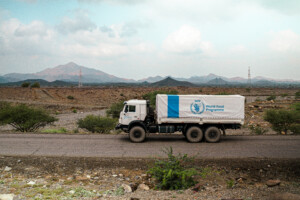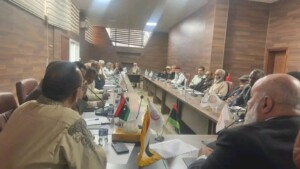Sudan OCHA bulletin 19: More Jebel Marra displaced arrive in Central, South Darfur
Civilians displaced by hostilities between government forces and the Sudan Liberation Army faction SLA-AW in Jebel Marra continue to arrive in various locations in Darfur. Tensions between armed locals and displaced in Sortony camp negatively affected the transport of drinking water. The influx of South Sudanese into East Darfur continues, though at a slower rate of arrival than in the previous two months.
More Jebel Marra displaced arrive in South Darfur
Civilians displaced by hostilities between government forces and the Sudan Liberation Army faction SLA-AW in Jebel Marra continue to arrive in various locations in Darfur. Tensions between armed locals and displaced in Sortony camp negatively affected the transport of drinking water. The influx of South Sudanese into East Darfur continues, though at a slower rate of arrival than in the previous two months.
Newly displaced people from Jebel Marra have been reported in South and Central Darfur states over the past week. Newly displaced people from Jebel Marra have arrived in Kass town and Nyala camps for displaced in South Darfur. Overall, new displaced from Jebel Marra have been reported in Kass, Nyala North, Mershing and Alweida localities, with the number of reported displaced standing at about 16,700 people.
Out of that reported number, the International Organization for Migration (IOM) has so far been able to initially register 8,660 displaced in Kass town and Otash camp, Nyala North locality where the provision of humanitarian assistance is ongoing. Further registration in other locations is scheduled for the next week.
Humanitarian access has improved, with partners currently able to access most locations of new reported displacement. Advocacy for access to Deribat and areas around Kass are ongoing.

Displaced reported in Central Darfur
On 4-5 May, an inter-agency team carried out registration and a needs assessment in Hassahissa and Hameedia camps in Zalingei town. It was found that an additional 2,666 people had arrived since April 20, bringing the total of registered newly displaced people in both camps to 4,295.
The new group came from 24 villages located in western and central Jebel Marra, as a result of the hostilities between the Sudan Armed Forces (SAF) and the SLA-AW. According to the team, about 90 percent of the new arrivals are women and children. The team has also received reports of cases of family separation and missing children.
Many women said that on their way to the camps in Zalingei they were exposed to harassment and witnessed violence. Their main needs are food, emergency shelter and essential non-food supplies, access to health and protection. There is also a need for family tracing and reunification where possible and provide psycho-social support to those in need of such assistance.
According to unconfirmed reports, between 40,000-90,000 people have been displaced in Boori, Wadi Boori and areas around Golo town. These reports cannot be verified due to lack of access.
Tension in Sortony, North Darfur
Tensions between local nomadic tribesmen and displaced people have been reported in Sortony, North Darfur where thousands of people displaced from Jebel Marra have been sheltering after hostilities started in the Jebel Marra area in mid-January. On 8 May, the armed tribesmen were said to have set up a check point to block all displaced and commercial trucks movements from or to Sortony.
This was reportedly prompted by a theft of cattle belonging to the nomadic tribesmen. On 9 May, six displaced civilians, including two children, were killed by armed local tribesmen outside of the camp site in Sortony.
Because of the tense situation, water was not trucked from Kabkabiya to Sortony on 8 May, with only 40,000 litres of water fetched from a nearby water source in Kubi. On average water and sanitation (WASH) sector partners have been trucking to Sortony about 250,000 litres of water per day prior to the tensions and road blockage.
Efforts are underway to ease the tensions and organise a reconciliation meeting between the leaders of nomads and IDPs. There are 33 aid workers from a government entity, national and international NGOs in Sortony providing basic services to the displaced.
Meanwhile, IOM’s registration and verification process in Sortony, North Darfur remains suspended by authorities since mid-February. Advocacy by the Humanitarian Country Team (HCT) for the resumption of IOM’s registration and verification processes is ongoing.
Following a headcount exercise carried out in Sortony in March, the World Food Programme (WFP) currently has 20,000 beneficiaries in Sortony receiving emergency food assistance. In Tawila, the number of WFP’s beneficiaries is 31,000 people.
Update on food security levels in Sudan
An Acute Food Security Situation Overview report has been released by the National Food Security Technical Secretariat (NFSTS) that is led and managed by the Ministry of Agriculture and Forestry, covering the period of April-July 2016. National production decreased by 30 percent, according to the report, compared to the previous season. Cause is the rainfall shortage resulted from El Niño.
However, the national cereal balance sheet showed no overall deficit in cereal, because of availability of above average carry-over stock from last year.
According to the report, about 20.6 million people in Sudan (56 percent of the total population of 37.1 million in all localities that were analysed) are in Phase 1 or experiencing None or Minimal levels of acute food insecurity, 12.1 million (33 percent) are in Phase 2 (Stressed), 4.3 million people (about 12 percent) are in Phase 3 (Crisis). About 140,000 people (less than 1 percent) are in Phase 4 (Emergency).
South Sudanese influx into East Darfur continues
The influx of South Sudanese into East Darfur continues, though at a slower rate of arrival than in the previous two months. Between 1-8 May, about 800 new arrivals were reported in East Darfur, mainly in Khor Omer camp near the state capital Ed Daein. The number of reported arrivals during 1-8 March stood at about 4,500 people and about 2,800 people during 1-9 April, according to the Sudanese Red Crescent Society (SRCS) and the Humanitarian Aid Commission (HAC).
Since late January, about 55,500 South Sudanese refugees have arrived in Darfur and West Kordofan mainly due to conflict and reported food shortages in Northern Bahr el Ghazal and Warrap states.
Food distributions for South Sudanese in Kordofan
WFP distributed 496 metric tonnes (MT) of assorted food supplies to 22,359 South Sudanese refugees in El Liri, Abu Gubaiha, Rashad, and Abassiya localities in South Kordofan, of whom 249 are reportedly new arrivals verified by a WFP team. These South Sudanese refugees received full ration for the month of April and half ration for May.
Measles vaccination campaign in West Kordofan
A vaccination campaign against measles started in West Kordofan as planned on 7 May 2016. The campaign will also cover all South Sudanese refugees in the state. The coverage during the first day of the campaign ranged from 17 to 40 percent in Babanusa locality.
In 2016, the number of confirmed measles cases in Sudan stands at 907, which is much lower compared to last year, according to Sudan's Ministry of Health (MoH). MoH says that most of the measles cases are in the states that did not implement the measles vaccination campaign last year, especially the Kordofan region, which accounts for about 75 per cent of the confirmed cases.











 and then
and then